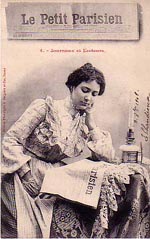 Return
to history/scholarship index.
Return
to history/scholarship index.
 Return
to history/scholarship index.
Return
to history/scholarship index.
What if we just started
over?
The French Press during World War II
By Ross Collins
Sometimes those of us exasperated
by media sensationalism and bias may like to muse: what would it be like if
we could just shut down every publication in the country and start over from
scratch? Of course, that’s impossible. Yet it actually happened once, and
not that long ago. It may be one of journalism history’s most amazing events,
yet perhaps not well known among a young generation of American historians.
On September 30, 1944, the government of France simply eliminated every periodical
published across the entire country. Every office, of every daily, of every
weekly, of every printed product, c’est fini—some 2,500 titles in
all.
To feel the magnitude of
such a decree, one might speculate on how a large country such as, say, the
United States might react if every title, including the New York Times,
Parade magazine, the Laramie Boomerang, even Linn’s Stamp
News, simply ceased to exist.
The French decree made
shortly after the country’s liberation was designed to create what French
press historians call the “table raze.” All periodicals which began
publishing after the defeat of 1940 were finished. All periodicals which continued
to publish in the occupied half of the country were also eliminated. All periodicals
which continued to publish after Vichy France, roughly the southern half of
the country, was occupied in November 1942 were also done for. Press property
was seized by the state.
This meant most every periodical
in print, although some non-political periodicals and a few important newspapers
which had fled Paris for Vichy France in 1940 were eventually allowed to reappear.
Many of these had voluntarily “scuttled themselves,” to use the French
term, after German occupying censors demanded they disavow the allied invasion
of North Africa.
Most obvious of an old
title allowed to reappear was Le Figaro,
today one of Paris’ largest dailies. Most obvious of an old title not allowed
to reappear was Le Temps, a venerable Paris daily still used today by
students as a French equivalent in authority of the Times of London or
the New York Times.
That Le Temps was
“collaborationist” and therefore eliminated is not the whole story.
In fact, Charles De Gaulle’s government of former resistance leaders set
the deadline for elimination of Vichy newspapers at 15 days after November 11,
1942. This meant Le Temps fell under the guillotine by a scant three
days, having appeared until November 29. No coincidence: the government targeted
this daily for its ties to a powerful steel trust. The “table raze”
was designed to eliminate not only collaborators, but the pre-war power of big
money to influence journalism. To replace Le Temps a new, government-sponsored
but journalist-controlled daily appeared, Le
Monde. Authorization to publish was given first to clandestine newspapers
which hazarded illegal publication during the occupation, second to newspapers
which had “scuttled” themselves during the occupation, and third to
new titles launched by former resistance fighters.
This idealistic plan to purify the press from taint of capital, and to distribute titles to a marketplace of ideas both left and right, failed. By the end of the decade many titles had disappeared, and the power of money and competition had edged back onto the familiar road of private industry.
(Excerpt from a book review of The Authorized Press in Vichy and German-Occupied France, 1940-1944. A Bibliography. Donna Evleth, compiler. Westport, Connecticut, and London: Greenwood Press, 1999, in American Journalism 18 [2001].)
Copyright 2004 by Ross F. Collins <www.ndsu.edu/communication/collins>